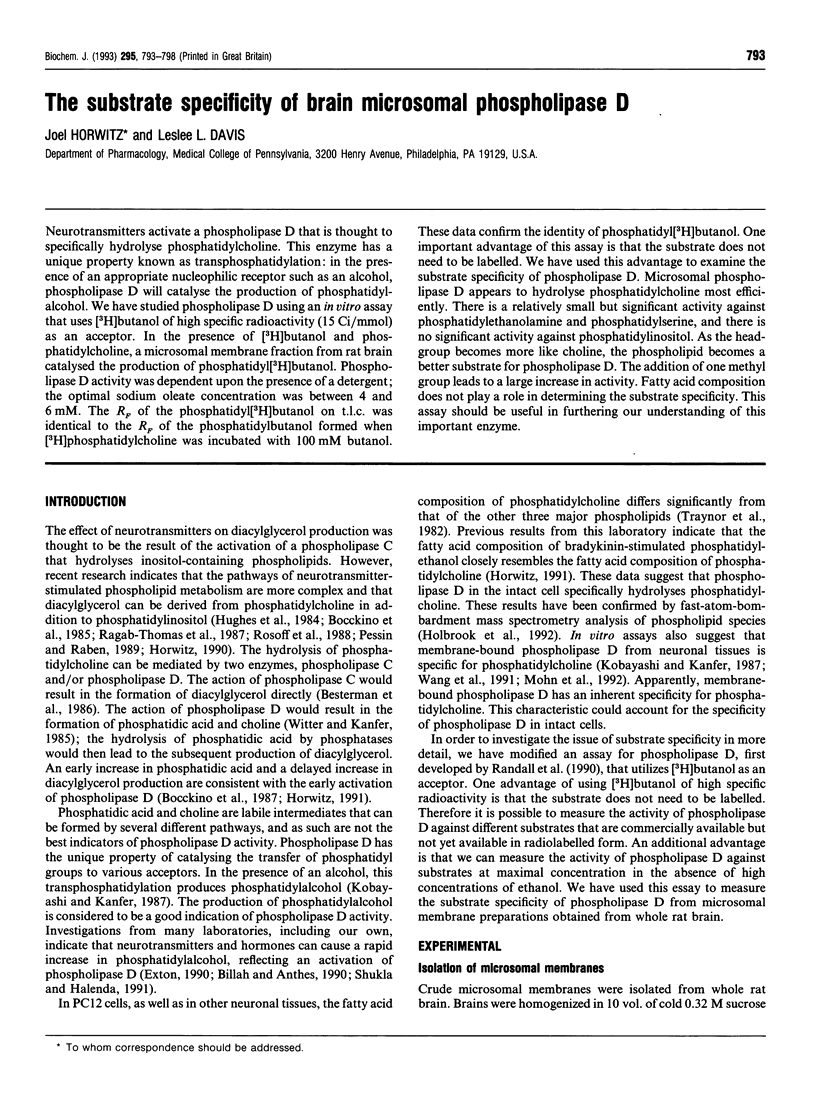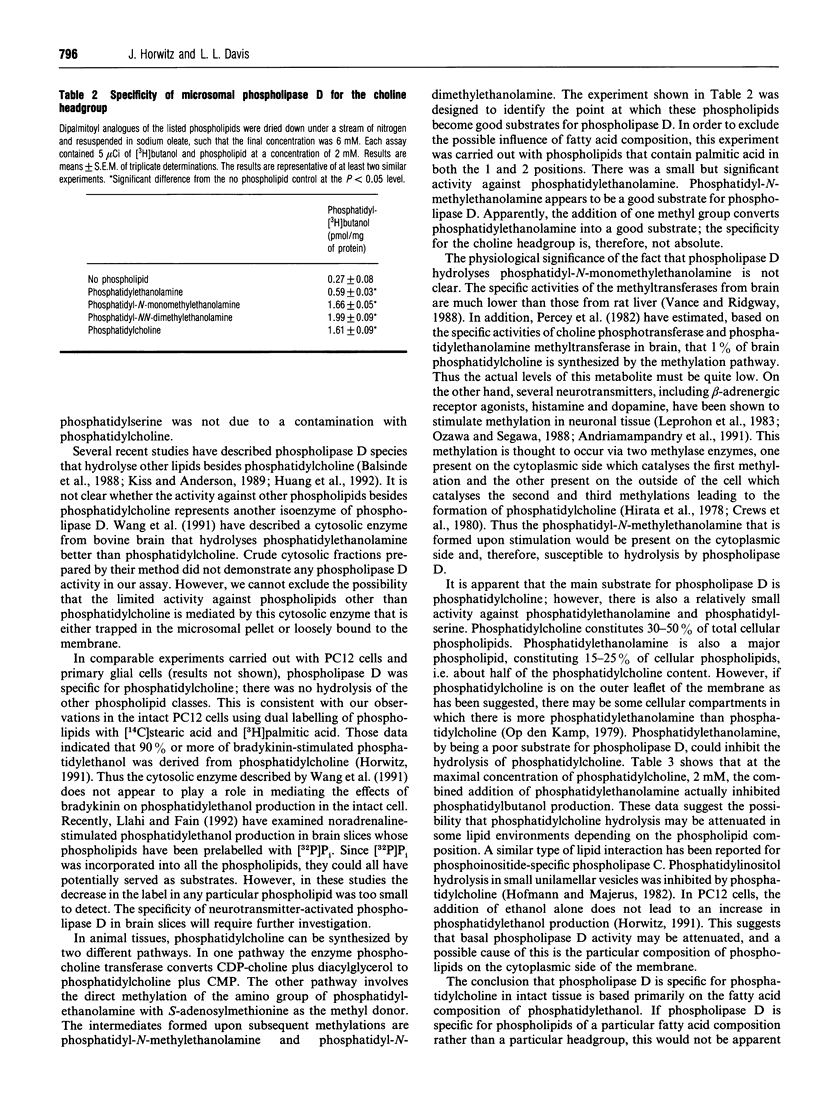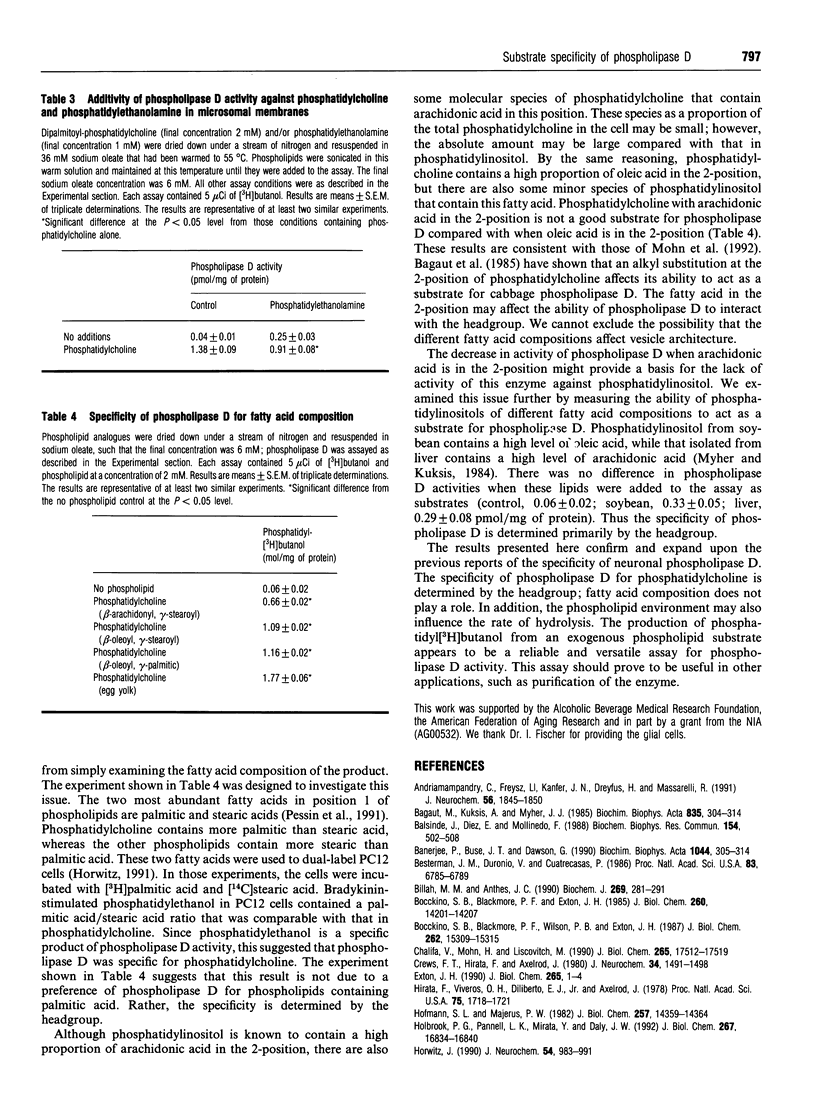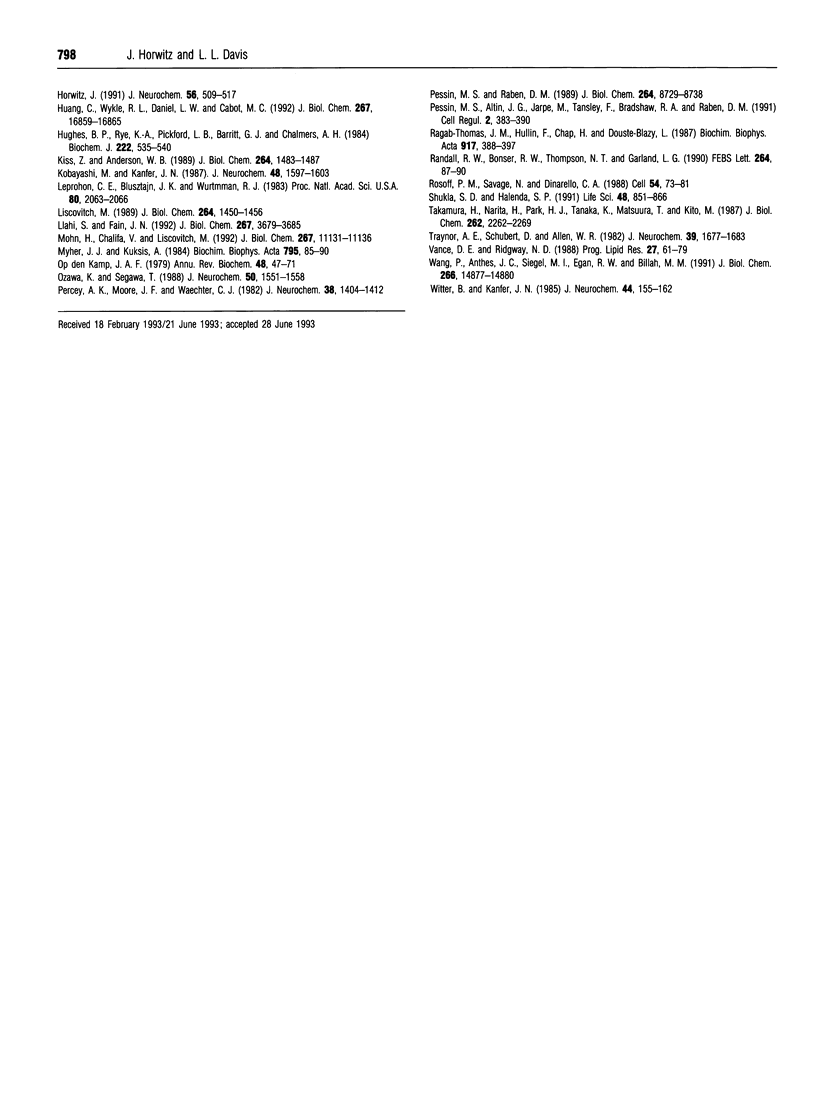Abstract
Neurotransmitters activate a phospholipase D that is though to specifically hydrolyse phosphatidylcholine. This enzyme has a unique property known as transphosphatidylation: in the presence of an appropriate nucleophilic receptor such as an alcohol, phospholipase D will catalyse the production of phosphatidyl-alcohol. We have studied phospholipase D using an in vitro assay that uses [3H]butanol of high specific radioactivity (15 Ci/mmol) as an acceptor. In the presence of [3H]butanol and phosphatidylcholine, a microsomal membrane fraction from rat brain catalysed the production of phosphatidyl[3H]butanol. Phospholipase D activity was dependent upon the presence of a detergent; the optimal sodium oleate concentration was between 4 and 6 mM. The RF of the phosphatidyl[3H]butanol on t.l.c. was identical to the RF of the phosphatidylbutanol formed when [3H]phosphatidylcholine was incubated with 100 mM butanol. These data confirm the identity of phosphatidyl[3H]butanol. One important advantage of this assay is that the substrate does not need to be labelled. We have used this advantage to examine the substrate specificity of phospholipase D. Microsomal phospholipase D appears to hydrolyse phosphatidylcholine most efficiently. There is a relatively small but significant activity against phosphatidylethanolamine and phosphatidylserine, and there is no significant activity against phosphatidylinositol. As the head-group becomes more like choline, the phospholipid becomes a better substrate for phospholipase D. The addition of one methyl group leads to a large increase in activity. Fatty acid composition does not play a role in determining the substrate specificity. This assay should be useful in furthering our understanding of this important enzyme.
Full text
PDF





Images in this article
Selected References
These references are in PubMed. This may not be the complete list of references from this article.
- Andriamampandry C., Freysz L., Kanfer J. N., Dreyfus H., Massarelli R. Effect of monomethylethanolamine, dimethylethanolamine, gangliosides, isoproterenol, and 2-hydroxyethylhydrazine on the conversion of ethanolamine to methylated products by cultured chick brain neurons. J Neurochem. 1991 Jun;56(6):1845–1850. doi: 10.1111/j.1471-4159.1991.tb03439.x. [DOI] [PubMed] [Google Scholar]
- Balsinde J., Diez E., Mollinedo F. Phosphatidylinositol-specific phospholipase D: a pathway for generation of a second messenger. Biochem Biophys Res Commun. 1988 Jul 29;154(2):502–508. doi: 10.1016/0006-291x(88)90168-4. [DOI] [PubMed] [Google Scholar]
- Banerjee P., Buse J. T., Dawson G. Asymmetric extraction of membrane lipids by CHAPS. Biochim Biophys Acta. 1990 Jun 14;1044(3):305–314. doi: 10.1016/0005-2760(90)90074-8. [DOI] [PubMed] [Google Scholar]
- Besterman J. M., Duronio V., Cuatrecasas P. Rapid formation of diacylglycerol from phosphatidylcholine: a pathway for generation of a second messenger. Proc Natl Acad Sci U S A. 1986 Sep;83(18):6785–6789. doi: 10.1073/pnas.83.18.6785. [DOI] [PMC free article] [PubMed] [Google Scholar]
- Billah M. M., Anthes J. C. The regulation and cellular functions of phosphatidylcholine hydrolysis. Biochem J. 1990 Jul 15;269(2):281–291. doi: 10.1042/bj2690281. [DOI] [PMC free article] [PubMed] [Google Scholar]
- Bocckino S. B., Blackmore P. F., Exton J. H. Stimulation of 1,2-diacylglycerol accumulation in hepatocytes by vasopressin, epinephrine, and angiotensin II. J Biol Chem. 1985 Nov 15;260(26):14201–14207. [PubMed] [Google Scholar]
- Bocckino S. B., Blackmore P. F., Wilson P. B., Exton J. H. Phosphatidate accumulation in hormone-treated hepatocytes via a phospholipase D mechanism. J Biol Chem. 1987 Nov 5;262(31):15309–15315. [PubMed] [Google Scholar]
- Bugaut M., Kuksis A., Myher J. J. Loss of stereospecificity of phospholipases C and D upon introduction of a 2-alkyl group into rac-1,2-diacylglycero-3-phosphocholine. Biochim Biophys Acta. 1985 Jul 9;835(2):304–314. doi: 10.1016/0005-2760(85)90286-3. [DOI] [PubMed] [Google Scholar]
- Chalifa V., Möhn H., Liscovitch M. A neutral phospholipase D activity from rat brain synaptic plasma membranes. Identification and partial characterization. J Biol Chem. 1990 Oct 15;265(29):17512–17519. [PubMed] [Google Scholar]
- Crews F. T., Hirata F., Axelrod J. Identification and properties of methyltransferases that synthesize phosphatidylcholine in rat brain synaptosomes. J Neurochem. 1980 Jun;34(6):1491–1498. doi: 10.1111/j.1471-4159.1980.tb11229.x. [DOI] [PubMed] [Google Scholar]
- Exton J. H. Signaling through phosphatidylcholine breakdown. J Biol Chem. 1990 Jan 5;265(1):1–4. [PubMed] [Google Scholar]
- Hirata F., Viveros O. H., Diliberto E. J., Jr, Axelrod J. Identification and properties of two methyltransferases in conversion of phosphatidylethanolamine to phosphatidylcholine. Proc Natl Acad Sci U S A. 1978 Apr;75(4):1718–1721. doi: 10.1073/pnas.75.4.1718. [DOI] [PMC free article] [PubMed] [Google Scholar]
- Hofmann S. L., Majerus P. W. Modulation of phosphatidylinositol-specific phospholipase C activity by phospholipid interactions, diglycerides, and calcium ions. J Biol Chem. 1982 Dec 10;257(23):14359–14364. [PubMed] [Google Scholar]
- Holbrook P. G., Pannell L. K., Murata Y., Daly J. W. Molecular species analysis of a product of phospholipase D activation. Phosphatidylethanol is formed from phosphatidylcholine in phorbol ester- and bradykinin-stimulated PC12 cells. J Biol Chem. 1992 Aug 25;267(24):16834–16840. [PubMed] [Google Scholar]
- Horwitz J. Bradykinin activates a phospholipase D that hydrolyzes phosphatidylcholine in PC12 cells. J Neurochem. 1991 Feb;56(2):509–517. doi: 10.1111/j.1471-4159.1991.tb08179.x. [DOI] [PubMed] [Google Scholar]
- Horwitz J. Carbachol and bradykinin increase the production of diacylglycerol from sources other than inositol-containing phospholipids in PC12 cells. J Neurochem. 1990 Mar;54(3):983–991. doi: 10.1111/j.1471-4159.1990.tb02347.x. [DOI] [PubMed] [Google Scholar]
- Huang C., Wykle R. L., Daniel L. W., Cabot M. C. Identification of phosphatidylcholine-selective and phosphatidylinositol-selective phospholipases D in Madin-Darby canine kidney cells. J Biol Chem. 1992 Aug 25;267(24):16859–16865. [PubMed] [Google Scholar]
- Hughes B. P., Rye K. A., Pickford L. B., Barritt G. J., Chalmers A. H. A transient increase in diacylglycerols is associated with the action of vasopressin on hepatocytes. Biochem J. 1984 Sep 1;222(2):535–540. doi: 10.1042/bj2220535. [DOI] [PMC free article] [PubMed] [Google Scholar]
- Kiss Z., Anderson W. B. Phorbol ester stimulates the hydrolysis of phosphatidylethanolamine in leukemic HL-60, NIH 3T3, and baby hamster kidney cells. J Biol Chem. 1989 Jan 25;264(3):1483–1487. [PubMed] [Google Scholar]
- Kobayashi M., Kanfer J. N. Phosphatidylethanol formation via transphosphatidylation by rat brain synaptosomal phospholipase D. J Neurochem. 1987 May;48(5):1597–1603. doi: 10.1111/j.1471-4159.1987.tb05707.x. [DOI] [PubMed] [Google Scholar]
- Leprohon C. E., Blusztajn J. K., Wurtman R. J. Dopamine stimulation of phosphatidylcholine (lecithin) biosynthesis in rat brain neurons. Proc Natl Acad Sci U S A. 1983 Apr;80(7):2063–2066. doi: 10.1073/pnas.80.7.2063. [DOI] [PMC free article] [PubMed] [Google Scholar]
- Liscovitch M. Phosphatidylethanol biosynthesis in ethanol-exposed NG108-15 neuroblastoma X glioma hybrid cells. Evidence for activation of a phospholipase D phosphatidyl transferase activity by protein kinase C. J Biol Chem. 1989 Jan 25;264(3):1450–1456. [PubMed] [Google Scholar]
- Llahi S., Fain J. N. Alpha 1-adrenergic receptor-mediated activation of phospholipase D in rat cerebral cortex. J Biol Chem. 1992 Feb 25;267(6):3679–3685. [PubMed] [Google Scholar]
- Myher J. J., Kuksis A. Molecular species of plant phosphatidylinositol with selective cytotoxicity towards tumor cells. Biochim Biophys Acta. 1984 Aug 15;795(1):85–90. doi: 10.1016/0005-2760(84)90107-3. [DOI] [PubMed] [Google Scholar]
- Möhn H., Chalifa V., Liscovitch M. Substrate specificity of neutral phospholipase D from rat brain studied by selective labeling of endogenous synaptic membrane phospholipids in vitro. J Biol Chem. 1992 Jun 5;267(16):11131–11136. [PubMed] [Google Scholar]
- Op den Kamp J. A. Lipid asymmetry in membranes. Annu Rev Biochem. 1979;48:47–71. doi: 10.1146/annurev.bi.48.070179.000403. [DOI] [PubMed] [Google Scholar]
- Ozawa K., Segawa T. Histamine increases phospholipid methylation and H2-receptor-adenylate cyclase coupling in rat brain. J Neurochem. 1988 May;50(5):1551–1558. doi: 10.1111/j.1471-4159.1988.tb03043.x. [DOI] [PubMed] [Google Scholar]
- Percy A. K., Moore J. F., Waechter C. J. Properties of particulate and detergent-solubilized phospholipid N-methyltransferase activity from calf brain. J Neurochem. 1982 May;38(5):1404–1412. doi: 10.1111/j.1471-4159.1982.tb07919.x. [DOI] [PubMed] [Google Scholar]
- Pessin M. S., Altin J. G., Jarpe M., Tansley F., Bradshaw R. A., Raben D. M. Carbachol stimulates a different phospholipid metabolism than nerve growth factor and basic fibroblast growth factor in PC12 cells. Cell Regul. 1991 May;2(5):383–390. doi: 10.1091/mbc.2.5.383. [DOI] [PMC free article] [PubMed] [Google Scholar]
- Pessin M. S., Raben D. M. Molecular species analysis of 1,2-diglycerides stimulated by alpha-thrombin in cultured fibroblasts. J Biol Chem. 1989 May 25;264(15):8729–8738. [PubMed] [Google Scholar]
- Ragab-Thomas J. M., Hullin F., Chap H., Douste-Blazy L. Pathways of arachidonic acid liberation in thrombin and calcium ionophore A23187-stimulated human endothelial cells: respective roles of phospholipids and triacylglycerol and evidence for diacylglycerol generation from phosphatidylcholine. Biochim Biophys Acta. 1987 Feb 23;917(3):388–397. doi: 10.1016/0005-2760(87)90117-2. [DOI] [PubMed] [Google Scholar]
- Randall R. W., Bonser R. W., Thompson N. T., Garland L. G. A novel and sensitive assay for phospholipase D in intact cells. FEBS Lett. 1990 May 7;264(1):87–90. doi: 10.1016/0014-5793(90)80772-b. [DOI] [PubMed] [Google Scholar]
- Rosoff P. M., Savage N., Dinarello C. A. Interleukin-1 stimulates diacylglycerol production in T lymphocytes by a novel mechanism. Cell. 1988 Jul 1;54(1):73–81. doi: 10.1016/0092-8674(88)90181-x. [DOI] [PubMed] [Google Scholar]
- Shukla S. D., Halenda S. P. Phospholipase D in cell signalling and its relationship to phospholipase C. Life Sci. 1991;48(9):851–866. doi: 10.1016/0024-3205(91)90031-6. [DOI] [PubMed] [Google Scholar]
- Takamura H., Narita H., Park H. J., Tanaka K., Matsuura T., Kito M. Differential hydrolysis of phospholipid molecular species during activation of human platelets with thrombin and collagen. J Biol Chem. 1987 Feb 15;262(5):2262–2269. [PubMed] [Google Scholar]
- Traynor A. E., Schubert D., Allen W. R. Alterations of lipid metabolism in response to nerve growth factor. J Neurochem. 1982 Dec;39(6):1677–1683. doi: 10.1111/j.1471-4159.1982.tb08002.x. [DOI] [PubMed] [Google Scholar]
- Vance D. E., Ridgway N. D. The methylation of phosphatidylethanolamine. Prog Lipid Res. 1988;27(1):61–79. doi: 10.1016/0163-7827(88)90005-7. [DOI] [PubMed] [Google Scholar]
- Wang P., Anthes J. C., Siegel M. I., Egan R. W., Billah M. M. Existence of cytosolic phospholipase D. Identification and comparison with membrane-bound enzyme. J Biol Chem. 1991 Aug 15;266(23):14877–14880. [PubMed] [Google Scholar]
- Witter B., Kanfer J. N. Hydrolysis of endogenous phospholipids by rat brain microsomes. J Neurochem. 1985 Jan;44(1):155–162. doi: 10.1111/j.1471-4159.1985.tb07125.x. [DOI] [PubMed] [Google Scholar]



